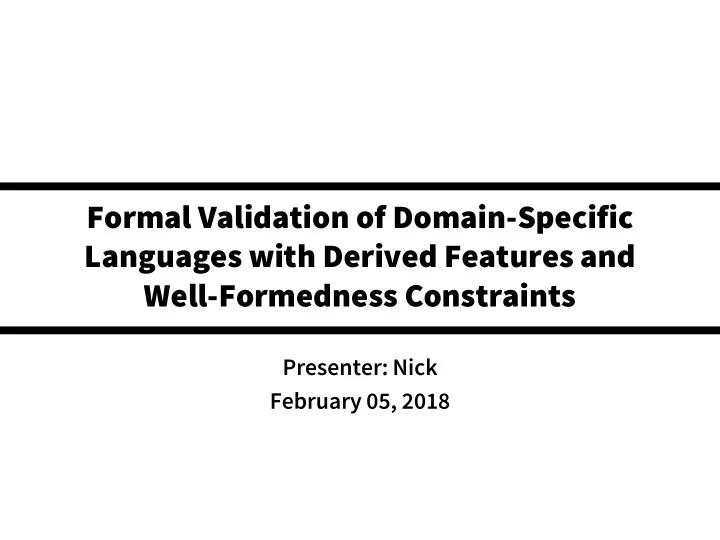

Formal Validation of Domain-Specific Languages with Derived Features and Well-Formedness Constraints Presenter: Nick February 05, 2018
Overview Motivation DSL Validation Tool DSL Validation Workflow Experimental Results Conclusions 1
Domain Specific Languages (DSLs) Components of a DSL Metamodel Derived features Well-formedness constraints 2
Domain Specific Languages (DSLs) Validation Challenges Complex metamodel and constraints Infinite range of models 3
SAT/SMT Solvers Properties Checks satisfiability of a logical claim. SMT is more expressive than SAT Satisfiable (Witness/ Counter-Example) Logical Unsatisfiable SAT/SMT formula Solver (Contradiction) Unknown (Timeout) 4
First-Order Logic (FOL) Approximation Original DSL 5
First-Order Logic (FOL) Approximation Original DSL Under- Approximation 5
First-Order Logic (FOL) Approximation Overapproximation Original DSL Under- Approximation 5
DSL Validation Tool 6
Formalisation of the Metamodel 7
Formalisation of the Metamodel Class 7
Formalisation of the Metamodel Class Relationships, Multiplicity & Inverse Edges 7
Formalisation of the Metamodel Class Relationships, Multiplicity Enumerations & Inverse Edges & Attributes 7
Formalisation of the Metamodel Class Type Hierarchy Relationships, Multiplicity Enumerations & Inverse Edges & Attributes 7
Formalisation of the Metamodel Class Containment Type Hierarchy Relationships, Multiplicity Enumerations & Inverse Edges & Attributes 7
Formalisation of Constraints Supported Constraints Classifier Path Equality Pattern call Check 8
Formalisation of Constraints Supported Constraints Usage Classifier Well-formed constraints Path Derived patterns Equality Pattern call Check 9
Partial Snapshots Relaxed Constraints Undefined attributes Abstract objects Unconnected partitions Missing/extra edges Removed objects 10
Partial Snapshots Relaxed Constraints Semantic Modifiers Undefined attributes Positive/Negative Abstract objects Injective/Shareable Unconnected partitions Modifiable/Unmodifiable Missing/extra edges Removed objects 10
DSL Validation Tool 11
DSL Validation Workflow
DSL Validation Workflow
DSL Validation Workflow
DSL Validation Workflow
DSL Validation Workflow
DSL Validation Workflow
Runtime Measurements Preliminary Results Z3 (SMT) generally outperforms Alloy (SAT) Alloy outperforms Z3 in model structure generation 13
The End Problem Validation of complex DSLs Approach Approximate DSL in first-order logic Check for satisfiability of resulting formula Convert witness/counterexample into model Discussion Points How well does the approach scale? Is it applicable to validating UML? What are “useful” constraints for a DSL? Is it applicable to synthesising constraints? 14
Recommend
More recommend